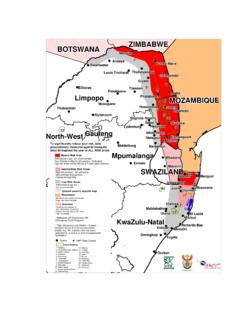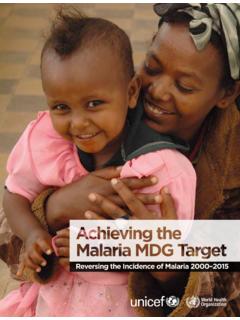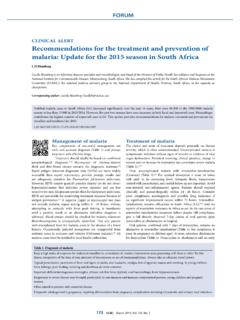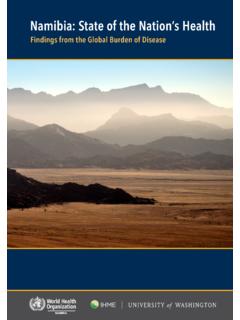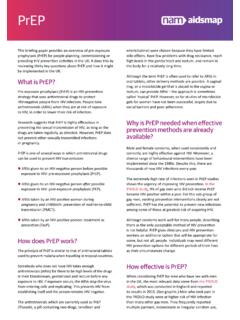Transcription of ITH country list - World Health Organization
1 country list1 Yellow fever vaccination requirements and recommendations; malaria situation; and other vaccination requirements Introduction The information provided for each country includes the country s stated requirements for yellow fever vaccination, WHO recommendation for travellers regarding yellow fever vaccinations, details concerning the malaria situation and recommended prevention of the disease, and other vaccination requirements for ,3 Yellow fever Yellow fever vaccination Yellow fever vaccination is carried out for two different purposes: 1.
2 To prevent the international spread of the disease by protecting countries from the risk of importing or spreading the yellow fever virus. These are requirements established by the country . The countries that require proof of vaccination2 are those where the disease may or may not occur and where the mosquito vector and potential non-human primate hosts of yellow fever are present. Any importation of the virus into such countries by infected travellers could result in its propagation and establishment, leading to a permanent risk of infection for the human population.
3 Proof of vaccination is often required for travellers arriving from countries with risk of yellow fever transmission and sometimes for travellers in transit through such countries. A meeting of yellow fever experts organized in 2010 proposed that under 12 hours of airport transit the risk of yellow fever is almost non-existent and therefore that a proof of vaccination might not be necessary. This information is being provided to WHO Member States, but travellers are recommended to consult individual country requirements by contacting the embassy of each country they intend to visit.
4 It should be noted that some countries require proof of vaccination from all travellers. Countries requiring yellow fever vaccination for entry do so in accordance with the International Health Regulations. country requirements are subject to change at any time. Updates can be found at: This chapter contains information on yellow fever requirements as provided by countries. The fact that a country has no requirement for yellow fever vaccination does not imply that there is no risk of yellow fever transmission. 2. To protect individual travellers who may be exposed to yellow fever infection.
5 The risk of yellow fever transmission depends on the presence of the virus in the country in humans, mosquitoes or animals. As yellow fever is frequently fatal for those who have not been vaccinated, vaccination is recommended for all travellers (with few exceptions, Chapter 6) visiting areas where there is a risk of yellow fever transmission. WHO determines those areas where a risk of yellow fever transmission is present on the basis of the diagnosis of cases of yellow fever in humans and/or animals, the results of yellow fever sero-surveys and the presence of vectors and animal Decisions regarding the use of yellow fever vaccine for travellers must weigh several factors, including the risk of travel-associated yellow fever virus disease, country requirements, and the potential for serious adverse events following yellow fever vaccination (Chapter 6).
6 The table below summarizes WHO s revised recommendations for yellow fever vaccination for travellers. Yellow fever vaccination category Rationale for recommendation Recommended Yellow fever vaccination is recommended for all travellers 9 months old in areas where there is evidence of persistent or periodic yellow fever virus transmission. Generally not recommended Yellow fever vaccination is generally not recommended in areas where there is low potential for yellow fever virus exposure (no human yellow fever cases ever reported and evidence to suggest only low levels of yellow fever virus transmission in the past).
7 However, vaccination might be considered for a small subset of travellers to these areas, who are at increased risk of exposure to mosquitoes or unable to avoid mosquito bites. When considering vaccination, any traveller must take into account the risk of being infected with yellow fever virus, country entry requirements, as well as individual risk factors ( age, immune status) for serious vaccine-associated adverse events. Annex 1 provides a summary list of countries with risk of yellow fever transmission in whole or in part, as well as a list of countries that require proof of yellow fever vaccination as a condition for entry.
8 Other diseases Cholera. No country reports a requirement for a certificate of vaccination against cholera as a condition for entry. For information on selective use of cholera vaccines, see Chapter 6. Smallpox. Since the global eradication of smallpox was certified in 1980, WHO does not recommend smallpox vaccination for travellers. Other infectious diseases. Information on the main infectious disease threats for travellers, their geographical distribution, and corresponding precautions are provided in Chapter 5. Chapter 6 provides information on vaccine-preventable diseases.
9 malaria General information about malaria , its geographical distribution and details of preventive measures are included in Chapter 7. Protective measures against mosquito bites are described in Chapter 3. Specific information for each country is provided in this section, including epidemiological details for all countries with malarious areas (geographical and seasonal distribution, altitude, predominant species, reported resistance). The recommended prevention is also indicated. For each country , recommended prevention is decided on the basis of the following factors: the risk of contracting malaria ; the prevailing species of malaria parasites in the area; the level and spread of drug resistance reported from the country ; and the possible risk of serious side-effects resulting from the use of the various prophylactic drugs.
10 Where Plasmodium falciparum and P. vivax both occur, prevention of falciparum malaria takes priority. Unless the malaria risk is defined as due exclusively to a certain species (P. falciparum or P. vivax), travellers may be at risk of any of the parasite species, including mixed infections. P. falciparum resistance to chloroquine and sulfadoxine pyrimethamine is at present nearly universal and is no longer specifically mentioned in the country list below; these two medications currently have no role in the prevention or treatment of falciparum malaria in travellers.











